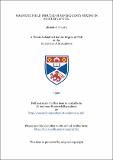Files in this item
Magnetic field induced sum frequency mixing in sodium vapour
Item metadata
| dc.contributor.advisor | Dunn, Malcolm H. | |
| dc.contributor.author | Poustie, Alistair J. | |
| dc.coverage.spatial | 191 p. | en_US |
| dc.date.accessioned | 2018-06-06T10:49:07Z | |
| dc.date.available | 2018-06-06T10:49:07Z | |
| dc.date.issued | 1990-07 | |
| dc.identifier.uri | https://hdl.handle.net/10023/13765 | |
| dc.description.abstract | A study of magnetic field induced sum frequency mixing (SFM) in sodium vapour was carried out using continuous-wave lasers as the sources of the fundamental radiation. The three-wave mixing nonlinear optical process was resonantly enhanced by tuning the laser frequencies close to single and two-photon resonances in the sodium atoms. The coherent ultraviolet radiation at the sum frequency of the two input laser frequencies was emitted by the coherently driven 3S-4D electric-quadrupole, which was rotated by the transverse magnetic field to allow collinear generation of the sum frequency wave. Two single-frequency dye lasers were used to examine in detail the role of the intermediate 3P atomic states in the coherent two-photon absorption. Resonant single photon transitions were investigated for the first time in a nonlinear optical process in an atomic vapour. High resolution SFM line profiles were obtained which illustrated the complicating contributions of hole-burning, velocity selection, optical pumping, saturation and frequency dependent phase mismatching to the three-wave mixing effect. The use of additional single photon resonant enhancement and control over the refractive index of the sodium vapour showed that large effective nonlinear X(2) susceptibilities were possible in atomic vapours which could exceed those of nonlinear crystals. The variation of SFM power with atomic particle density due to bulk phase mismatching reflected the wavelength dependence of the sodium dispersion with the 3P intermediate state off-resonance. Phase shifts of the focused Gaussian laser beams led to an asymmetric behaviour of the phase matching with respect to the sign of the phase mismatch k. Saturation spectroscopy was utilised for the first time to examine the Zeeman spectra of the sodium 3S-3P D line resonances in a transverse magnetic field. A novel experimental method was used to restrict the detrimental effects of velocity changing collisions on the resolution of the nonlinear laser spectroscopic technique. The possibility of using optical pumping with a transversal, resonant light beam to induce the second-order nonlinearity necessary for second harmonic generation in sodium vapour was experimentally investigated. | en_US |
| dc.language.iso | en | en_US |
| dc.publisher | University of St Andrews | |
| dc.subject.lcc | TK7871.3P7 | |
| dc.subject.lcsh | Lasers | |
| dc.title | Magnetic field induced sum frequency mixing in sodium vapour | en_US |
| dc.type | Thesis | en_US |
| dc.contributor.sponsor | Carnegie Trust for the Universities of Scotland | en_US |
| dc.type.qualificationlevel | Doctoral | en_US |
| dc.type.qualificationname | PhD Doctor of Philosophy | en_US |
| dc.publisher.institution | The University of St Andrews | en_US |
This item appears in the following Collection(s)
Items in the St Andrews Research Repository are protected by copyright, with all rights reserved, unless otherwise indicated.

